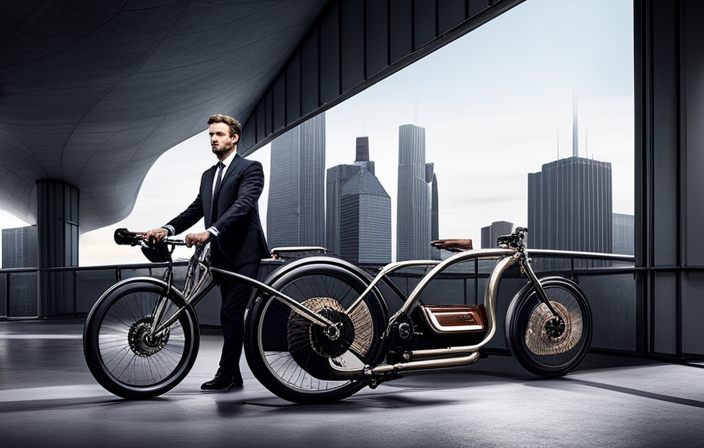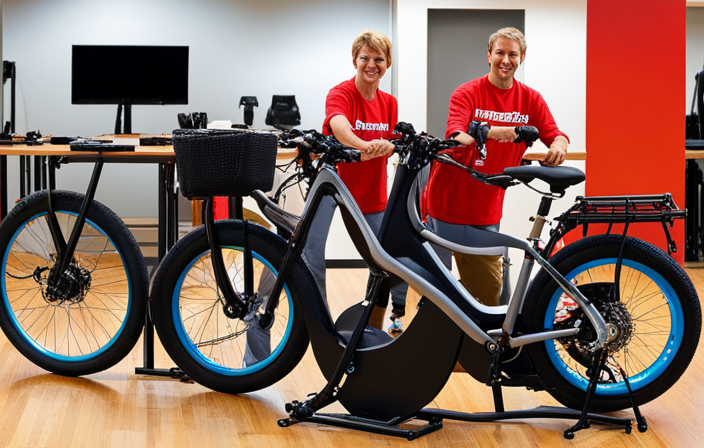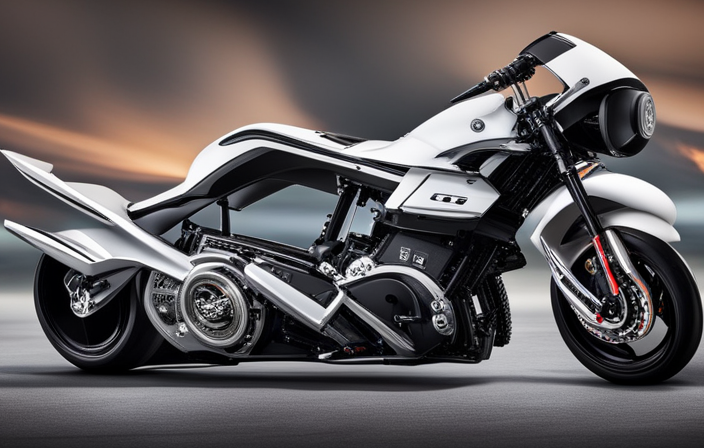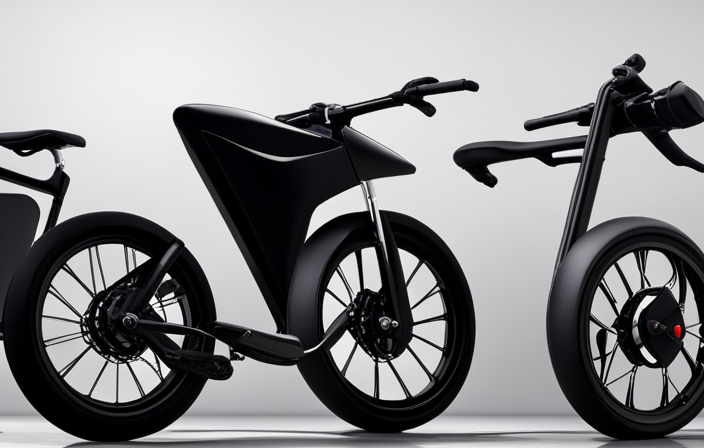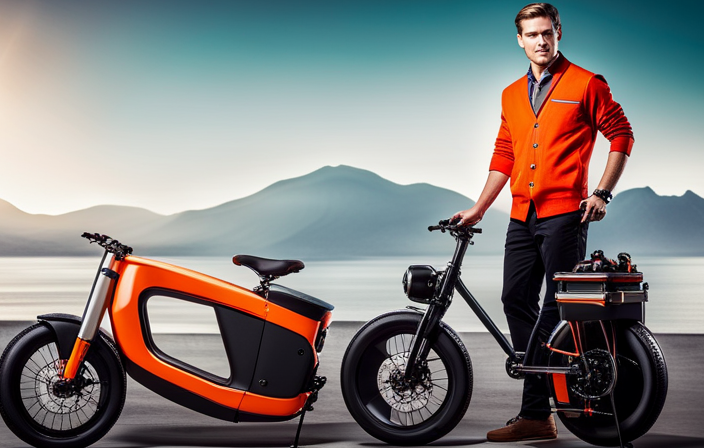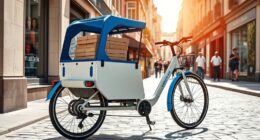Want to transform your regular pedal bike into an electric powerhouse? Look no further! This article will guide you step-by-step on how to make your bike electric.
Are you ready to experience the thrill of effortless speed and extended rides? Gather the tools and materials, prepare your bike, and install the electric conversion kit.
Get ready to ride in style and learn how to maintain your electric bike for years of excitement and adventure.
Let’s get started!
Key Takeaways
- Regular maintenance is important for optimal bike condition and performance.
- Proper tire pressure is crucial for a smooth and efficient ride.
- Regular inspection and replacement of brake pads ensure safety and optimal braking performance.
- Safety should always be a priority when riding an electric bike.
Assess Your Bike’s Compatibility
You’ll need to determine if your bike’s frame, wheels, and brakes are compatible with an electric conversion kit.
First, let’s talk about the frame. Electric conversion kits typically require a frame with enough clearance to accommodate the added components, such as the motor and battery. Check if your bike has enough space between the frame and the wheels, as well as around the bottom bracket area.
Next, consider the wheels. Electric bikes can be heavier than regular bikes, so it’s essential to ensure that your wheels are sturdy enough to handle the increased weight and provide a safe ride.
Lastly, evaluate the brakes. Electric bikes often require more stopping power due to their increased speed. Make sure your bike’s brakes are in good condition and can handle the added demands.
Once you’ve assessed your bike’s compatibility, you can move on to gathering the necessary tools and materials for the conversion process.
Gather the Necessary Tools and Materials
To get started, gather all the tools and materials you need for the project. Before you begin converting your pedal bike into an electric one, it’s important to have everything you’ll need within reach. Here is a table listing the essential tools and materials for the conversion:
| Tools | Materials |
|---|---|
| Wrench | Electric motor |
| Screwdriver | Battery pack |
| Pliers | Controller |
| Wire cutters | Throttle |
| Allen wrench set | Wiring harness |
Prepare Your Bike for Conversion
Once you’ve gathered all the necessary tools and materials, it’s time to assess your bike’s frame, brakes, and other components to ensure they’re compatible with the conversion process. Here are a few key steps to get you started:
-
Check the frame: Examine the frame of your bike to ensure it’s in good condition and sturdy enough to handle the additional weight of the electric conversion kit.
-
Inspect the brakes: Make sure your bike’s brakes are in optimal working condition. Strong and responsive brakes are crucial for safety when riding an electric bike.
-
Evaluate the drivetrain: Take a close look at your bike’s drivetrain, including the chain, gears, and derailleur. Ensure they’re in good shape and can handle the increased power and torque of the electric motor.
Now that you’ve assessed your bike’s readiness for the conversion, let’s move on to installing the electric conversion kit.
Install the Electric Conversion Kit
Now that you’ve checked your bike’s compatibility, it’s time to begin installing the conversion kit. Before starting, make sure you have all the necessary tools and equipment. Here’s a step-by-step guide to help you with the installation process:
| Step | Procedure |
|---|---|
| 1 | Remove the bike’s rear wheel and disconnect the brakes. |
| 2 | Attach the electric motor to the frame using the provided brackets. |
| 3 | Connect the motor controller to the motor and secure it in place. |
| 4 | Install the battery holder and connect it to the controller. |
| 5 | Mount the throttle and connect it to the controller. |
| 6 | Reattach the rear wheel, making sure it is aligned properly. |
| 7 | Connect the brakes and adjust them for optimum performance. |
Once you have successfully installed the conversion kit, you can move on to the next step of testing and adjusting the electric system for optimal performance.
Test and Adjust the Electric System
To ensure the optimal performance of your electric system, there are a few key points to consider.
First, check for proper functionality by inspecting all connections and components for any signs of damage or wear.
Next, adjust the electric assist settings to match your desired level of assistance, taking into account factors such as terrain and rider preference.
Finally, fine-tune the braking and shifting to ensure smooth and efficient operation, making any necessary adjustments to cable tension or brake pad alignment.
Check for Proper Functionality
Make sure you’re checking for proper functionality before proceeding further with converting your pedal bike into an electric one. This step is crucial to ensure that all components are working correctly and will provide a smooth and efficient electric biking experience.
Start by checking the battery and making sure it is fully charged. Test the motor by engaging the electric assist and observing if it runs smoothly and quietly. Check the throttle to see if it responds accurately and smoothly. Inspect the wiring connections to ensure they are secure and free from any damage.
Additionally, test the brakes and make sure they are responsive and effective. By thoroughly checking for proper functionality, you can address any issues before proceeding to adjust the electric assist settings, ensuring a successful conversion process.
Adjust the Electric Assist Settings
Ensure that you adjust the electric assist settings properly to achieve the desired level of assistance while biking. Follow these steps to adjust the settings effectively:
- Increase the assist level to feel a stronger push with each pedal stroke.
- Decrease the assist level for a more natural biking experience.
- Experiment with different levels to find the perfect balance of assistance and effort.
By adjusting the electric assist settings, you can tailor the biking experience to your preferences.
Once you have achieved the desired level of assistance, you can then move on to fine-tuning the braking and shifting.
Fine-Tune the Braking and Shifting
Now that you have adjusted the electric assist settings on your pedal bike, it’s time to fine-tune the braking and shifting mechanisms to ensure a smooth and efficient ride. Properly functioning brakes and gears are essential for maintaining control and safety while riding.
To help you understand the different components involved, refer to the table below:
| Component | Function |
|---|---|
| Brakes | Control the speed and bring the bike to a stop |
| Brake levers | Activate the brakes when squeezed |
| Brake cables | Transmit the force from the levers to the brake calipers |
| Gears | Allow you to change the bike’s resistance for different terrains |
| Shifters | Control the movement of the derailleur to change gears |
Take the time to inspect and adjust these components according to the manufacturer’s instructions. This will ensure that your bike is in optimal condition for a smooth and enjoyable ride.
In the next section, you will learn how to ride and maintain your electric bike, ensuring its longevity and performance.
Learn How to Ride and Maintain Your Electric Bike
When riding an electric bike, it’s important to regularly check the tire pressure and brake pads for proper maintenance.
Maintaining the correct tire pressure is crucial for a smooth and efficient ride. Low tire pressure can affect the bike’s performance and make pedaling more difficult. Use a tire gauge to measure the pressure and inflate the tires accordingly.
Additionally, inspect the brake pads to ensure they are in good condition. Worn brake pads can decrease braking performance and compromise your safety. Look for any signs of wear or damage, such as thinning or uneven surfaces. If necessary, replace the brake pads to maintain optimal stopping power.
Conclusion
Congratulations! You’ve successfully transformed your pedal bike into an electric marvel. But the journey doesn’t end here.
As you embark on this new adventure, keep in mind that maintaining and riding your electric bike comes with its own set of challenges. From learning how to handle the increased speed and power to ensuring regular maintenance, there’s much to discover.
So, buckle up and get ready for an electrifying ride that will keep you on your toes, pushing the boundaries of what you thought was possible.
Enjoy the thrill!
